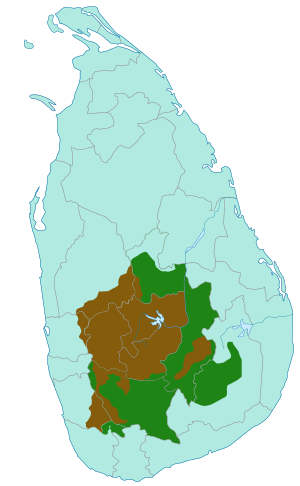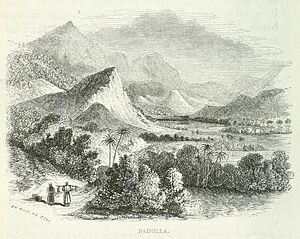Coffee production in Sri Lanka facts for kids
Coffee farming in Sri Lanka was once a huge deal! In 1870, over 111,400 hectares (about 275,000 acres) of land were covered with coffee plants. The Dutch tried growing coffee in the 1700s, but it wasn't very successful. It was only when the British started growing coffee on a large scale after 1833 that it really took off. By 1860, Sri Lanka was one of the world's top coffee-producing countries. Today, coffee still brings in money, but it's not the main part of the economy anymore. In 2014, Sri Lanka was the 43rd largest coffee producer globally.
Contents
History of Coffee in Sri Lanka
The first arabica coffee plants might have come to Sri Lanka from Yemen through India. This was around the early 1600s, brought by Muslim travelers. However, the local Sinhalese didn't know how to make coffee drinks from the berries. They only used the young leaves in curries and the flowers as offerings in their temples.
Early Attempts by the Dutch
The Dutch were the first to try growing coffee in an organized way in 1740. This effort was led by governors like Gustaaf Willem van Imhoff. But their attempts were mostly in the lowlands and didn't produce much coffee. The Dutch also didn't want too much competition with their coffee farms in Java. By 1762, Sri Lanka only produced about 100,000 pounds of coffee each year.
British Take Over and the "Coffee Rush"
The British arrived in Sri Lanka in 1796 and took full control by 1815. They continued trying to grow coffee. Early attempts near Galle failed because the land wasn't right for coffee. The first person to successfully grow coffee for sale was George Bird in Singhapitiya. Then, Edward Barnes, who became the Governor in 1824, started another farm in Gannoruwa in 1825. This area is now part of the Royal Botanical Gardens, Peradeniya. Other government officials also started farms.
One of the few local people to grow coffee on a large scale was Jeronis de Soysa. About a quarter of all coffee came from small farms run by local farmers. Many of these early farms didn't make much money. This was due to unsuitable land in the lowlands, competition from the West Indies, and poor roads.
Things changed when coffee was planted in the mountainous Kandyan area in 1827. A few years later, coffee farming spread to many other parts of the country and became very profitable.

Sri Lankan coffee farming really grew when the West Indies stopped using enslaved labor, which affected their coffee production. The British government in Sri Lanka also sold land they had taken from the kings of Kandyan. This opened up more land for coffee farms. By the 1830s, many Tamil workers came from South India to help on these farms.
Between 1830 and 1850, coffee production helped Sri Lanka develop a lot. The Bank of Ceylon supported many coffee estates, which led to better roads and buildings in the Kandyan region. This period was even called the "Coffee rush" in 1840!
However, there was a worldwide economic downturn in 1846. Coffee prices fell, causing problems. Taxes were introduced to make up for the money lost. In 1848, a system was put in place to make people work, which led to some unrest. This was later settled. Despite these challenges, the coffee farming era changed Sri Lanka. Nearly one-third of the farm land was owned by local people. With high demand and good prices for coffee in Europe, more and more coffee was planted. Investors came to Sri Lanka from other countries. About 100,000 hectares (about 250,000 acres) of rainforest were cleared to make way for coffee farms. By 1860, Sri Lanka, Brazil, and Indonesia were the three biggest coffee-producing countries in the world.
The "Devastating Emily" Disease
In 1869, the coffee industry in Sri Lanka was still doing very well. But soon after, a serious problem hit. A fungal disease called Hemileia vastatrix, also known as coffee leaf rust (CLR), destroyed coffee farms. This disease affected not only Sri Lanka but also other parts of Asia over the next 20 years. The farmers nicknamed the disease "Devastating Emily." Coffee production dropped very quickly. By 1900, coffee was only grown on about 11,392 acres (4,610 hectares) of land. Because of this, coffee was largely replaced by tea farming.
Coffee Production Today
According to records from 2019, Sri Lanka produced 7,688 tons of coffee from an area of 6,445 hectares. This means about 6,373 hectograms (or 637 kilograms) of coffee were produced per hectare. Between 1961 and 2013, the most coffee produced was 25,575 tons in 1967. The lowest was 4,109 tons in 1988. In 2019, Sri Lanka was the 35th largest coffee producer globally. In recent years, Sri Lanka's coffee production has increased by 84%, reaching nearly $355,000 by 2019. Over the past 10 years, the growth has mainly been in arabica coffee, which grows well in wet and hilly areas. About 80% of coffee production comes from small farms.
Revival of Coffee Farming
Coffee production in Sri Lanka is starting to grow again! Since 2014, more cafes and restaurants in Colombo and other cities are using high-quality local coffee beans. They are buying beans from local farmers instead of importing them. This shows a promising future for Sri Lankan coffee.


